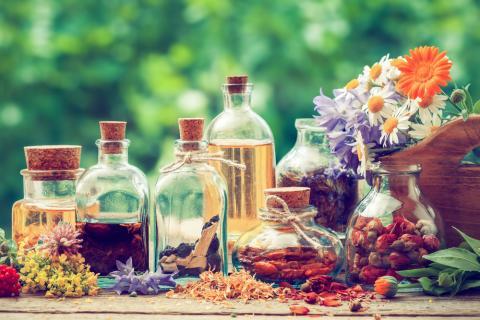
An “infused oil” is a vegetable oil in which herbs, spices, or plant resins have been infused. They’re fun to make and immensely useful. First, let’s look at uses, then how to make an oil, and finally, I’ll share some of my favorite oils.
Infused Oil Uses
Cosmetic for skin and hair care: For example, rosemary-infused olive oil is a great scalp and hair treatment. Rosemary Gladstar talks about it for making hair darker and thicker. It works! Though it didn’t fix my gray…it just darkened what was still brown. Infused oils can be used for scarring, sun damage, dry hair, dandruff, dull skin…the list goes on!
Food prep: Herb and spice-infused oils are great in cooking. Mix a little in with your regular cooking fat/oil, drizzle some over a dish as a finishing touch, use in salad dressings. You can have a collection of herb and spice infused oils to use for recipes. You’re only limited by your creativity!
Medicine: In my small practice, infused oils have been helpful for shingles, cold sores, poor circulation, cellulite, sprains, pulled muscles, muscle cramps and more.
Perfumery: Scented plants and resins are great for making scented body products without having to buy expensive essential oils. You can even capture the scent of such plants as lilac, honeysuckle, and gardenia that don’t lend themselves to essential oil distillation. Your oil can be used straight as a body oil or as a base for salves, lotions, and creams.
Making Infused Oils
Here are the two methods that I use most. You can geek out online and find lots of other methods.
1. Window sill method
This is the good, old-fashioned way and is best for certain plants such as St. John’s Wort. Fill a clean jar about 1/2 to 3/4 of the way with your plant (more for fresh, less for dry) and cover with enough vegetable oil to submerge the plant. Olive, jojoba, almond, grapeseed, and coconut oil are all good options, depending on the purpose of your oil. For instance, when scent is the goal, use a relatively unscented base oil like jojoba, almond, or grapeseed. When medicinal use is more important, olive and coconut oils are great.
With fresh plants, replace the solid lid insert of a canning jar with cheesecloth to allow the water to evaporate. (This isn’t necessary for dry plant bits.) Set the jar on a sunny windowsill for 3-6 weeks. Or, if worried about direct sunlight hitting your herbs, you can simply place the jar in another warm spot out of the sun. I used to set my jars on a cast iron gas stove with just the pilot flame going…the surface was about 100-110 degrees…perfect!
For fresh plants, a couple ways to reduce the risk for microbial growth during the infusion include wilting the plant overnight before setting up the infusion and also having your jar filled almost completely. The less air the better, but keep in mind that the oil will expand with even low heat and possibly overflow. “Why bother with fresh plants?”, you may ask. Some plants won’t work dry for an oil infusion…St. John’s Wort, for instance.
2. Blender method
This is Michael Moore’s method for certain plants, but modified slightly. This approach works for plant bits that don’t have a lot of water content—for example, rosemary, thyme, and calendula (this latter one after wilting overnight first). This also works well for aromatic seeds/fruits like peppercorns, juniper, and cardamom, as well as for resins such as frankincense, myrrh, and copol (these will make your blender sticky!). Don’t use this method for watery plants—fresh mint, for example. The oil will mold. Add your plant bits to the blender, cover with oil, and blend for 4-5 minutes…long enough that the mix warms up. I use the medium/high setting where my blender is stuck after dropping it (!). This breaks up the plant matter and the heat aids the infusion. After blending, pour the mix into a clean jar. At this point, you can simply cap the jar and let it sit overnight. What I prefer to do instead is put the jar in a pot of water and heat on low for 30-60 minutes. Don’t let the water get hot enough to boil. Then let the jar sit overnight with cheesecloth on top.
For either the traditional or blender method, strain and pour the oil into a new clean jar. Let it sit 8 hours to overnight so that any plant or water residue settles to the bottom. Carefully remove the oil and store it in the fridge, keeping a small “working stock” out for use. This slows rancidity, prolonging the life of your oil.
3 Useful Infused Oils
1. Rosemary Infused Oil
Blender or Traditional method. Hair growth and darkening; dry, aging or sun-damaged skin; warming muscle liniment; sciatica; flavoring for fish, poultry, potatoes, other veggies, popcorn.
2. Goldenrod Infused Oil
Traditional method, wilt overnight before using. Tense or injured muscles, joint injuries. Useful right after an injury but during the recovery process as well. Combines well with St. John’s Wort for this.
3. Lavender Infused Oil
Blender or Traditional method. Baking; cocktails/mocktails; small amount on whitefish after cooking; scented body products; stretch marks; scar reduction; shingles (great with St. John’s Wort!); cold sores (ditto!); pain; cuts; burns; skin infection. Apply around edges of cut, not directly inside. For burns, wait a couple days…adding an oil too soon will increase heat.








